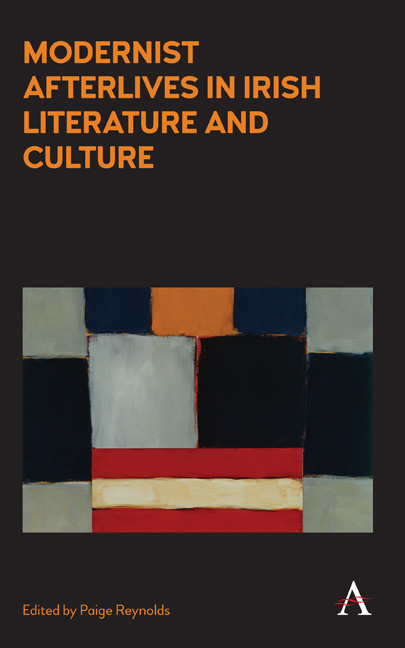Book contents
- Frontmatter
- Contents
- List of Figures
- Acknowledgements
- Introduction
- Section One LITERATURE AND LANGUAGE
- Section Two INSTITUTIONS, ART AND PERFORMANCE
- Chapter 7 ‘Make a Letter Like a Monument’: Remnants of Modernist Literary Institutions in Ireland
- Chapter 8 Storm in a Teacup: Irish Modernist Art
- Chapter 9 ‘Particles of Meaning’: The Modernist Afterlife in Irish Design
- Chapter 10 Animal Afterlives: Equine Legacies in Irish Visual Culture
- Chapter 11 Choreographies of Irish Modernity: Alternative ‘Ideas of a Nation’ in Yeats's At the Hawk's Well and Ó Conchúir's Cure
- Chapter 12 The Modernist Impulse in Irish Theatre: Anu Productions and the Monto
- Afterword: The Poetics of Perpetuation
- Notes on Contributors
- Index
Chapter 9 - ‘Particles of Meaning’: The Modernist Afterlife in Irish Design
from Section Two - INSTITUTIONS, ART AND PERFORMANCE
Published online by Cambridge University Press: 22 July 2017
- Frontmatter
- Contents
- List of Figures
- Acknowledgements
- Introduction
- Section One LITERATURE AND LANGUAGE
- Section Two INSTITUTIONS, ART AND PERFORMANCE
- Chapter 7 ‘Make a Letter Like a Monument’: Remnants of Modernist Literary Institutions in Ireland
- Chapter 8 Storm in a Teacup: Irish Modernist Art
- Chapter 9 ‘Particles of Meaning’: The Modernist Afterlife in Irish Design
- Chapter 10 Animal Afterlives: Equine Legacies in Irish Visual Culture
- Chapter 11 Choreographies of Irish Modernity: Alternative ‘Ideas of a Nation’ in Yeats's At the Hawk's Well and Ó Conchúir's Cure
- Chapter 12 The Modernist Impulse in Irish Theatre: Anu Productions and the Monto
- Afterword: The Poetics of Perpetuation
- Notes on Contributors
- Index
Summary
Far from being a neutral, inoffensive artistic activity, design, by its very nature, has much more enduring effects […] because it can cast ideas about who we are and how we should behave in permanent, tangible forms[; …] the history of design is also the history of societies.
The record of history is inherently problematic: it is subjective and fractured, making our understanding of any civilization inherently incomplete. Irish literature is one measure of Irish cultural history, but this chapter considers a parallel history of creative expression, Irish design, to explore how the modernist afterlife became manifest through architecture, graphic design and other popular forms. Design history is the study of ideas in material and visual form; it is not merely concerned with aesthetics and the skill of making, but with what objects and images reveal about the cultural, political and economic factors from which they emerge. In design terms, as in other realms, modernism as a historical and conceptual category is a term in flux. Despite modernism's stated intention to comprise a universal ideology, historians – including Martin Daunton and Bernhard Rieger – argue that modernity embodies both ‘continuity and rupture’, which necessitates the investigation of ‘modernities’ as opposed to understanding modernism as an all-encompassing and monolithic concept. Design historian David Crowley expands this thesis by arguing that modernism is localized within specific cultural and national contexts. He regards the emergence of regional inflections and interpretations as ‘national’ or ‘regional’ modernisms, an approach that speaks to the recent acknowledgement of a distinct Irish or vernacular modernism, a negotiated form of expression closely aligned with nation-building and state sponsored projects.
If the afterlife of Irish literary modernism arises after the publication of Joyce's Finnegans Wake (1939), this marks the period when modernism in design came into its fullest expression. Modernism is somewhat easier to define in material and visual terms than in the context of literature or other fields where definitions can be contested. Design historian Peter Greenhalgh offers that there were three phases to historical modernism in relation to design: Proto-Modernism, which signalled the break with historicism that emerged in the materiality of the late nineteenth and early twentieth centuries…
- Type
- Chapter
- Information
- Modernist Afterlives in Irish Literature and Culture , pp. 125 - 140Publisher: Anthem PressPrint publication year: 2016



